Wilson J. Richard. Minerals and Rocks
Подождите немного. Документ загружается.


Download free books at BookBooN.com
Minerals and Rocks
101
Igneous rocks
The upper surface of a lava flow cools rapidly against the air and a solidified crust forms, below which lava
continues to flow in well defined channels. The pre-existing topography has a major influence on the course
of the flowing lava which will follow valleys. The flow may be concentrated in lava tubes and liquid lava (if
its viscosity is low enough) may flow for considerable distances from the vent. Lava near the vent can flow
smoothly to give "ropy" lava (pahoehoe; section 5.2.4) but as viscosity increases with cooling it flows less
readily and form a "blocky" surface (aa lava; section 5.2.4).
As lava cools its viscosity increases and escaping bubbles become trapped in the solidifying lava. These
bubbles, which retain their original sub-spherical shape, are called vesicles and the resulting rock would be,
for example, vesicular basalt. With time, vesicles can gradually become filled with crystalline material (e.g.
calcite, quartz) as fluids circulating through the rocks deposit the material they have in solution. Vesicles that
have become filled by such secondary minerals are called amygdules, and the resulting rock would be, for
example, and amygdaloidal andesite.
The majority of volcanic eruptions take place beneath the sea along mid-oceanic ridges. The basaltic lava
that is erupted is immediately cooled by seawater and large blobs of lava are formed with glassy rims (very
rapidly chilled lava). The central part of the blob remains hot for some time. These "blobs" solidify to form
what is known as pillow lava (Fig. 5.10).
what‘s missing in this equation?
maeRsK inteRnationaL teChnoLogY & sCienCe PRogRamme
You could be one of our future talents
Are you about to graduate as an engineer or geoscientist? Or have you already graduated?
If so, there may be an exciting future for you with A.P. Moller - Maersk.
www.maersk.com/mitas
Please click the advert
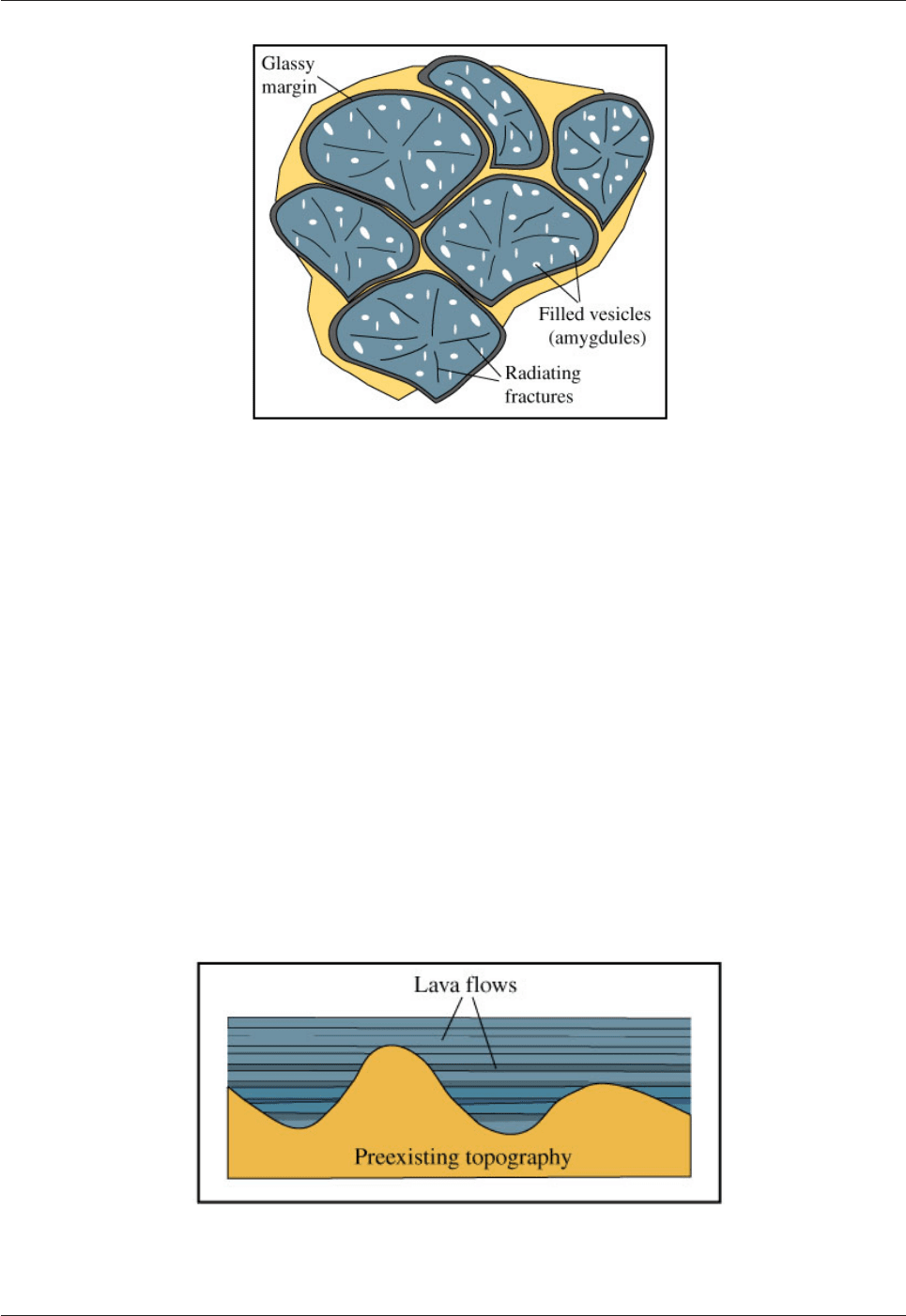
Download free books at BookBooN.com
Minerals and Rocks
102
Igneous rocks
Fig. 5.10: Pillow-shaped bodies are formed when lava comes into contact with water.
They are particularly common along mid-ocean ridges. The can sometimes be used as a “way-up” criterion
in ancient, deformed rocks.
Pillows lie in a pile that resembles a heap of sand bags. Seawater can react with the hot lava that can change
its composition, most importantly involving the introduction of water and sodium (from the salt water) into
the pillows. Basaltic lava that is erupted on the sea floor therefore differs from that erupted on land by having
pillow structures and by being relatively enriched in H
2
O and Na
2
O.
The history of the Earth has been punctuated by several short (a few millions of years) periods involving the
eruption of huge quantities of basaltic lava above hotspots (section 5.2.1.). In the north-western USA, the
Columbia River basalts in Oregon and Washington originally covered an area of ca. 163.000km
2
and had a
volume of 174.300km
3
. Some of the individual lava flows had volumes >2000km
3
. This huge amount of
basaltic lava was erupted from fissures (not from central volcanoes) over a period of about 3 million years
some 17-14 million years ago (Mid-Miocene). The basaltic lavas inundated and "drowned" the pre-existing
topography and formed a huge plateau which was up to 10km thick (Fig. 5.11). These provinces are known
as flood basalts or plateau basalts.
Fig. 5.11: Plateau (or “flood”) lavas drown the pre-existing topography.
Enormous volumes of lava are produced in plateau lava provinces.

Download free books at BookBooN.com
Minerals and Rocks
103
Igneous rocks
The Columbia River Province is not the largest of its kind - there are about 10 that are larger elsewhere in the
world. Those in Siberia (Permo-Trias), the Karoo area of South Africa (Jurassic) and in the Parana area of
Brazil (Cretaceous) covered areas of >2.000.000km
2
.
5.3.2 Explosive eruptions
Magmas with elevated gas contents and high viscosities are liable to erupt extremely violently. This is
because the gas released during pressure decrease as magma approaches the surface cannot escape gradually.
When the pressure within the magma exceeds the confining pressure, gas escapes in an explosive manner.
An extreme example of this causes the formation of pumice. This is a rock which consists entirely of very
thin glass-walled vesicles; there are so many bubbles (vesicles) relative to glass that pumice can float on water.
The escape of gas can be so violent that the magma breaks into tiny glassy fragments called volcanic ash.
5.3.2.1 Pyroclasts and tephra
The products of volcanism are commonly hot (Greek = pyro) fragments (clasts) and are known as pyroclastic
rocks. Deposits formed of pyroclasts are known as tephra deposits which are named according to their size.
Tephra is the name used for the unconsolidated (young) deposit; other names are used for the consolidated
rock (Table 5.6).
Average particle diameter
(mm)
Tephra (unconsolidated
material)
Pyroclastic rock (consolidated
material)
> 64
bombs
agglomerate
2-64 lapilli lapilli tuff
< 2
ash
ash tuff
Table 5.6. Nomenclature for tephra and pyroclastic rocks
5.3.2.2 Eruption columns and tephra falls
The most violent explosive eruptions involve viscous magma with a high gas content. This is particularly the
case for rhyolitic magmas which are silica-rich and have a highly polymerised melt structure.
Decompression of the rising magma results in the rapid escape of huge volumes of hot gas which rise into
the air together with tephra to form an eruption column. These columns can reach as high as 45km up into
the atmosphere.
At the level in the atmosphere where the density of the cooling column reaches that of the air it spreads out
laterally to form an anvil-shaped cloud. This cloud will drift with the prevailing wind. Particles will fall from
this drifting cloud and accumulate as tephra deposits. The climactic eruption of Mt. Mazama 6600 years ago
which gave rise to Crater Lake (Oregon, USA) produced a 30cm-thick layer of ash some 130km away from
the vent, and mm-thick layers some 1100km away. Fine volcanic dust from such eruptions can become
entrained in the upper atmosphere so that dispersal is global and produce multi-coloured sunsets over long
time periods.

Download free books at BookBooN.com
Minerals and Rocks
104
Igneous rocks
5.3.2.3 Pyroclastic flows
Probably the most devastating type of volcanic eruption involves highly mobile, hot mixtures of gas and
ejecta that move swiftly along the ground from an explosive vent. Pyroclastic flows deposit sheets consisting
of a mixture consisting of a matrix of ash with fragments of glass, pumice and crystals, as well as accidental
lithic clasts. These flows can cover up to thousands of square kilometers with thicknesses of a few meters up
to a few hundred meters. The origin of these sheets was first understood after observation of the eruption on
May 8th, 1902, of Mt. Pelée on the island of Martinique, West Indies. Some 29.000 people were killed. Two
terms that are commonly used for pyroclastic flows are "nuée ardente" (French for "glowing cloud") that
illustrates the nature of the flow, and "ignimbrite" (Latin "ignis" = fire; "nimbus"= cloud) for the poorly
sorted deposit.
Please click the advert
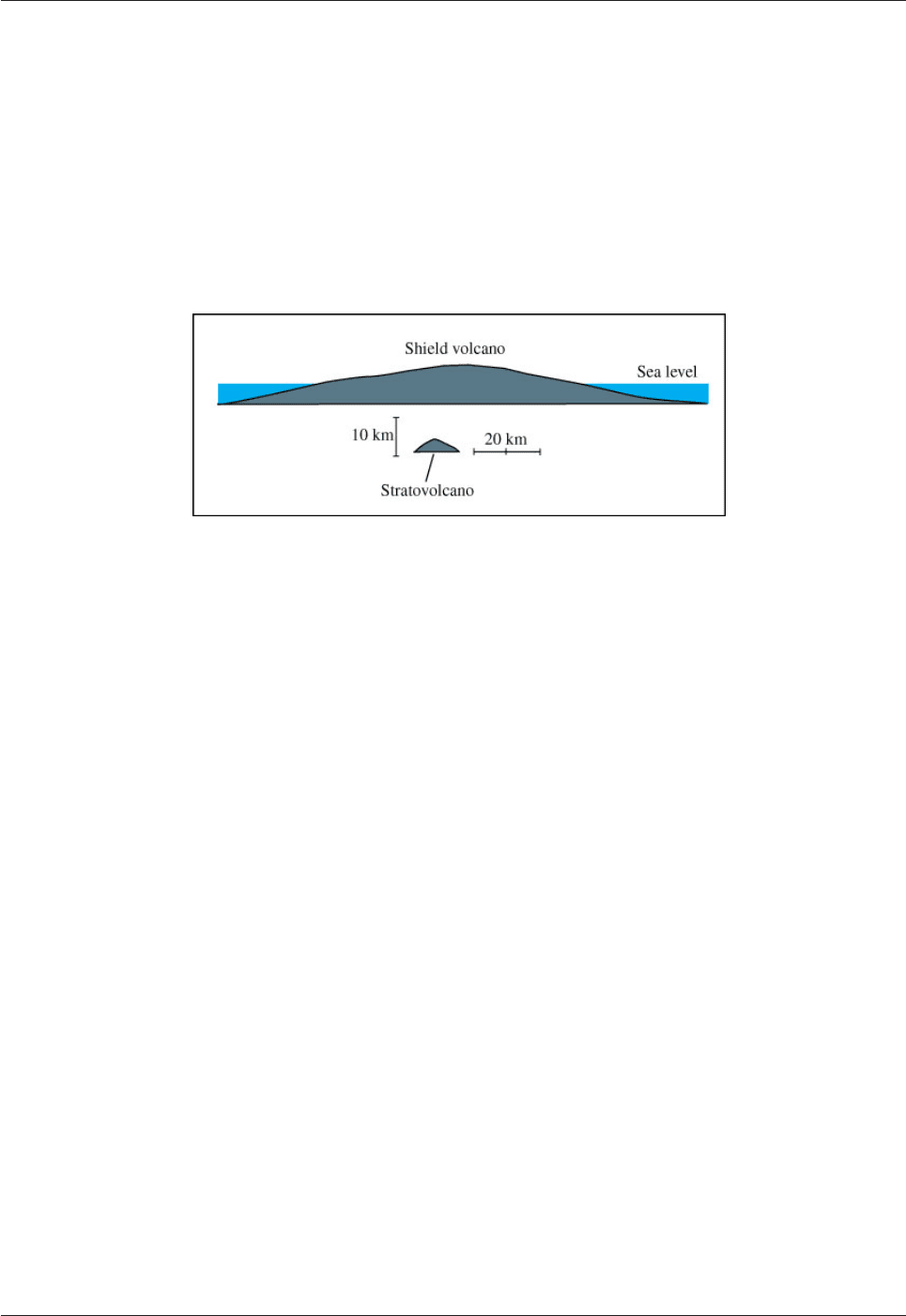
Download free books at BookBooN.com
Minerals and Rocks
105
Igneous rocks
5.4 Volcanoes
5.4.1 The shapes of volcanoes
The largest volcanoes on Earth are shield volcanoes because their shape resembles that of a warrior´s shield.
The Hawaiian Islands rise as much as 10km above the sea floor and have diameters of over 100km. They are
largely built up of successive flows of low-viscous basaltic lava with relatively little pyroclastic (explosive)
material. The slopes of young shield volcanoes are usually between 5° and 10° (Fig. 5.12).
Fig. 5.12: Comparative sizes and shapes of shield (for example Muana Loa, Hawaii) and
stratovolcanoes (for example Mt. Fuji, Japan).
Shield volcanoes are by far the largest in the world.
Eruptions commonly involve lava fountains in which tephra is thrown into the air. The tephra is deposited
near the vent to form a conical pile called a tephra cone. The size of the tephra is such (in the range of 2-
64mm in diameter) that these usually consist dominantly of lapilli. The slopes of tephra cones are typically
about 30°. Volcanoes that dominantly consist of material more viscous than basalt, such as andesite,
typically produce pyroclastic material (i.e. explosive products) in addition to lava flows. These so-called
stratovolcanoes build up steep conical mounds. This is because the relatively viscous lava cannot flow very
far, and the tephra deposits accumulate close to the vent.
5.4.2 Calderas
There is a magma chamber beneath most volcanoes. As magma is withdrawn from the chamber to be
extruded via the volcano (or more than one volcano) it can be partially emptied. The roof is then unsupported
and can collapse into the chamber. This commonly takes place along ring-shaped fractures. This collapse of
a huge block of rocks into the magma chamber is accompanied by a major (usually explosive) eruption. The
result is a circular depression called a caldera (Fig. 5.13). Large calderas are developed around Mt. Teide on
Tenerife and related to the Greek island of Santorini where most of the caldera is below the sea but some of
the steep circular walls are visible. Crater Lake in Oregon, USA, is the result of caldera collapse.
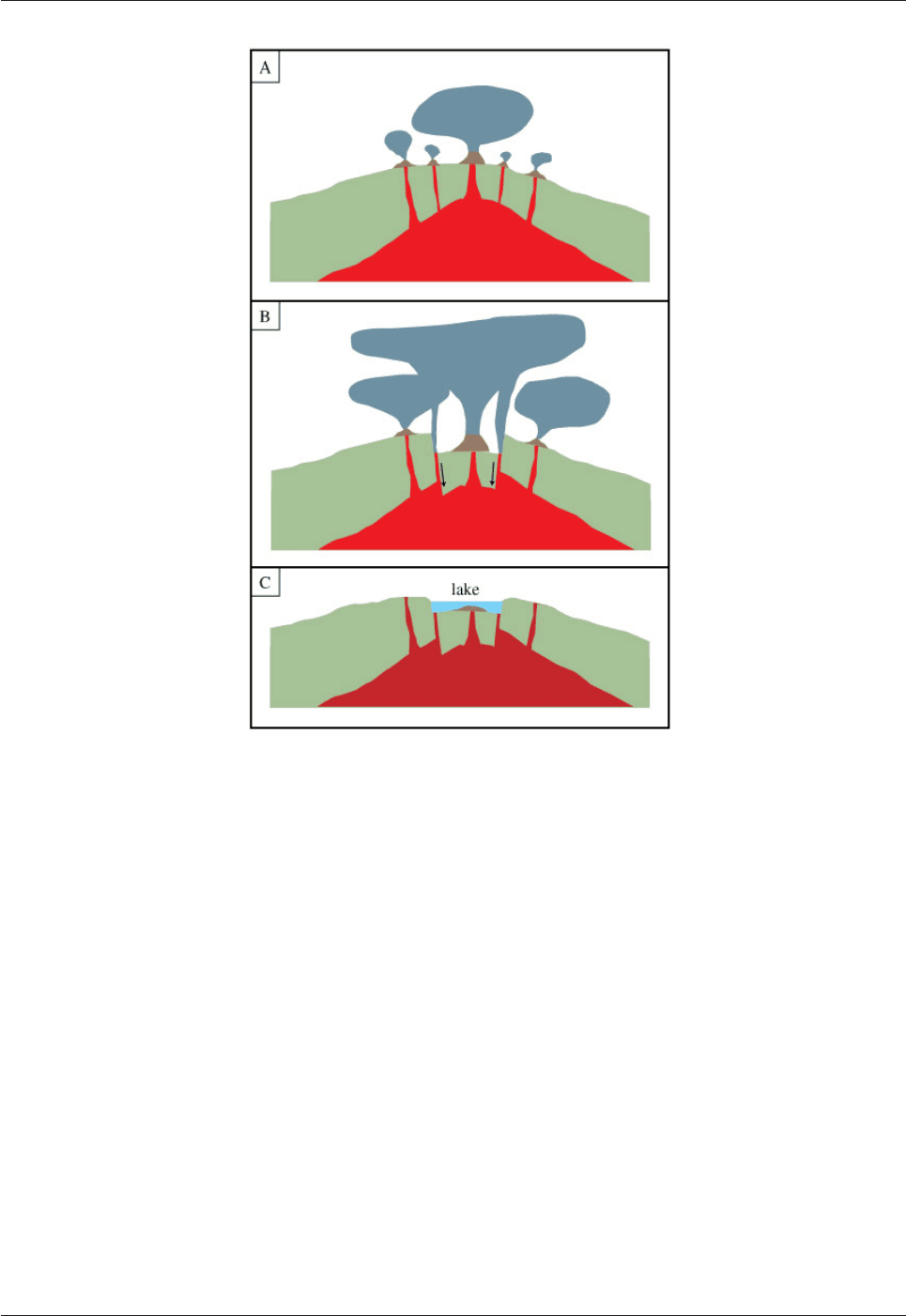
Download free books at BookBooN.com
Minerals and Rocks
106
Igneous rocks
Fig. 5.13: Three stages in the formation of a caldera.
A. Eruptions from volcanoes above a magma chamber results in partial emptying of the chamber. This
results in B, collapse of the volcano(es) into the chamber. This is usually associated with an enormous
explosive event. Collapse usually occurs along ring-fractures. Subsequent erosion results in (C) a circular-
shaped depression that can be occupied by a lake.
5.5 Plutonic rocks
Volcanic rocks are extruded at the surface; plutonic rocks are the crystalline products of magma that has
intruded into the crust and solidified beneath the surface. Different types of plutons are named according to
their style and size.
5.5.1 Minor intrusions (dykes and sills)
On its way towards the surface, magma is commonly intruded along more or less vertical fractures. The
magma, which is under pressure, forces its way upward, opening and filling a fissure. The magma
subsequently solidifies to form a tabular, sheet-like body called a dyke (Fig. 5.14). Dykes may reach the
surface and act as feeders to volcanoes. Dykes are commonly 20cm-20m wide but narrower and wider ones
also occur.

Download free books at BookBooN.com
Minerals and Rocks
107
Igneous rocks
Fig. 5.14: Sills and dykes.
Dykes are more or less vertical sheets of igneous rock. They are commonly feeder channels for volcanoes.
Sills are emplaced more or less horizontally, parallel with bedding in sedimentary rocks.
Magma intruded in a dyke commonly cuts across more or less horizontal sedimentary rocks. It may be easier
for the magma to spread out laterally between two layers of sediment than to continue upwards to the
surface. Tabular, sheet-like bodies that form parallel to the layering are called sills. Sills can locally be
transgressive to the sedimentary bedding. The Whin Sill in northern England strikes roughly east-west and
locally forms a steep escarpment towards the north. The Roman emperor Hadrian built a wall on top of this sill.
it’s an interesting world
Where it’s
Student and Graduate opportunities in IT, Internet & Engineering
Cheltenham | £competitive + benefits
Part of the UK’s intelligence services, our role is to counter threats that compromise national and global
security. We work in one of the most diverse, creative and technically challenging IT cultures. Throw in
continuous professional development, and you get truly
interesting work, in a genuinely inspirational business.
To find out more visit
www.careersinbritishintelligence.co.uk
Applicants must be British citizens. GCHQ values diversity and welcomes applicants from all sections of the community.
We want our workforce to reflect the diversity of our work.
Please click the advert
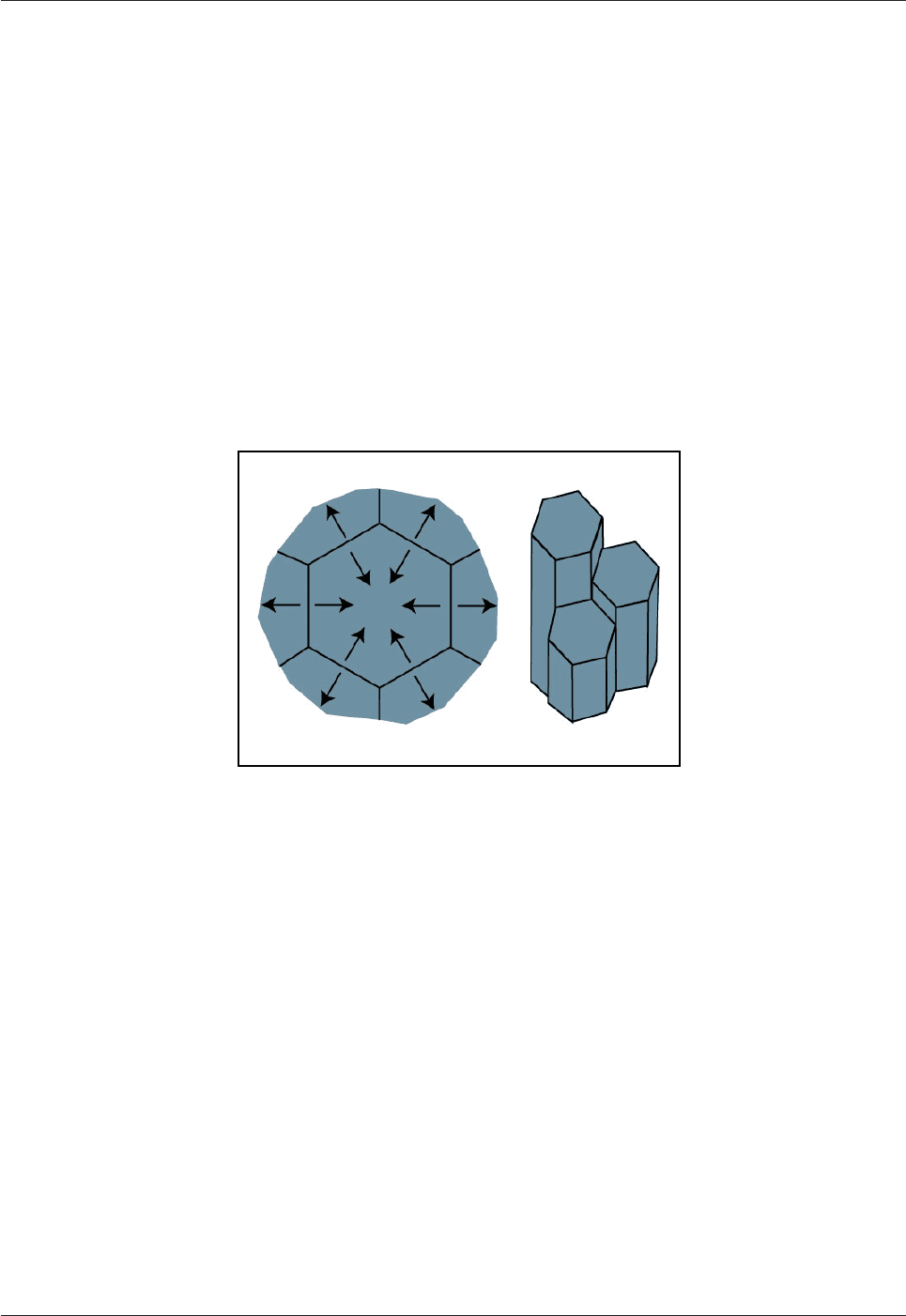
Download free books at BookBooN.com
Minerals and Rocks
108
Igneous rocks
Instead of spreading out laterally to form a sill, the magma may form a bulge by pushing up the overlying
rocks to form a dome-shaped feature called a laccolith.
Volcanoes may be fed by cylindrical pipes rather than dykes. Magma can solidify in this type of conduit to
form a volcanic pipe. If the surrounding rocks are eroded away to leave the pipe as a resistant feature it is
known as a volcanic neck.
A feature that is commonly developed in dykes and sills, and sometimes in lava flows, is columnar jointing
(Fig. 5.15). As the solidified magma cools it contracts. Cooling is largely through the walls of the intrusion
and contraction results in the development of cracks normal to the cooling surface. The cracks usually form
polygonal shapes, as is commonly observed in drying out mud. These cracks result in the development of
polygonal columns. Almost perfectly hexagonal columns are developed at Giant´s Causeway in Northern
Ireland.
Fig. 5.15: The formation of columnar jointing in cooling volcanic rocks.
Contraction during cooling commonly results in the development of polygonal cracks perpendicular to the
cooling surface. The resulting columns can be extremely symmetrical.
5.5.2 Major intrusions (plutons)
The largest kind of pluton is called a batholith. Most batholiths consist of a large number of smaller plutons,
but each of these can have surface areas of several 100km
2
(Fig. 5.16a). The total area of the largest
batholiths (which comprise hundreds of intrusions) is more than 1000 x 250km. Huge batholiths occur in the
Andes and in the western USA and Canada. Batholiths, which cut across the enveloping rocks (i.e. they are
discordant bodies), are dominantly composed of granitic rocks. Granitic magma, formed by the partial
melting of continental crustal rocks (Fig. 5.16b), rose towards the surface in diapiric-like bodies (well
illustrated by "lava lamps") because their density was lower than the enveloping rocks.
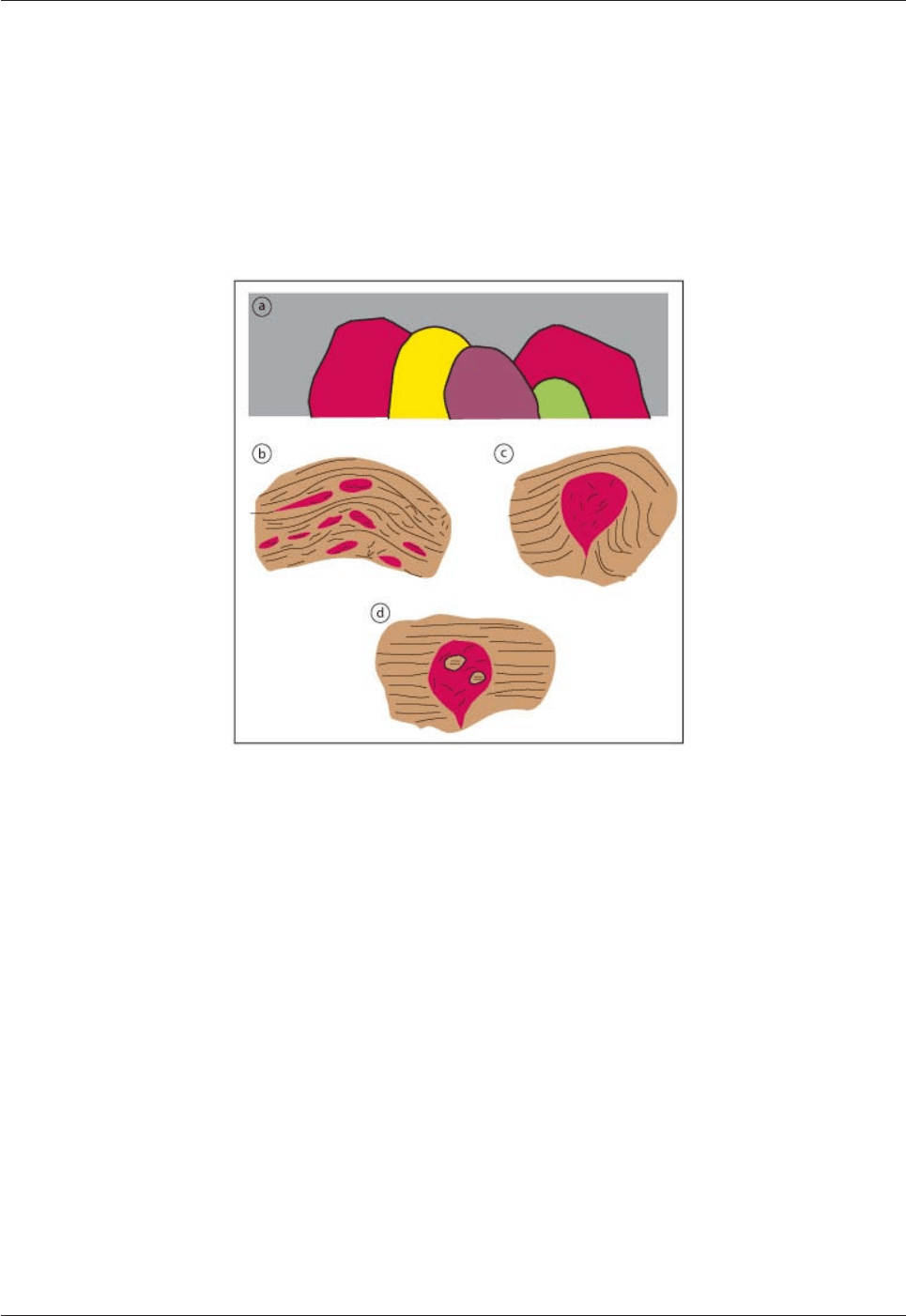
Download free books at BookBooN.com
Minerals and Rocks
109
Igneous rocks
At low levels in the crust these country rocks would behave in a plastic manner and could be deformed (Fig.
5.16c); higher up they would be less deformable and would fracture (Fig. 5.16d). Blocks of country rock can
be broken off and fragments sink though the rising magma (a process called stoping). These fragments of
foreign rock (called xenoliths) can react with the magma and be assimilated or survive to be visible in the
solidified granite. Small, high level plutons may be referred to as stocks. Intrusive diapirs of granitic magma
can form successively and intrude previous intrusions to form a complex of intrusions with cross-cutting
relationships.
Fig. 5.16: Batholiths and the forms of granitic intrusions at different crustal depths.
a) Batholiths consist of a number of individual plutons. b) Granitic magma forms by the partial melting of the
lower continental crust. c) The buoyant magma rises diapirically through the plastic lower crust and deforms
the surrounding rocks. d) At higher levels the crust behaves in a brittle fashion and fractures. Blocks of
country rock (xenoliths) become enveloped in the magma.
Magma chambers filled by basaltic magma commonly form funnel-shaped bodies with a feeder channel at
the base, gradually broadening upwards (Fig. 5.17). Magma chambers of this type are commonly filled by
many influxes of magma. The resulting magma mixing can be responsible for the formation of important
economic mineral deposits of, for example, chromium and platinum-group elements.

Download free books at BookBooN.com
Minerals and Rocks
110
Igneous rocks
Fig. 5.17: Repeated magma influx is commonly involved in the formation of magma chambers.
Funnel-shaped magma chambers (filled here by six major influxes of magma) are common for mafic
intrusions. The dimensions are usually in the range 2-10km thick and 5-100km across. This type of intrusion
may be layered.
Please click the advert
